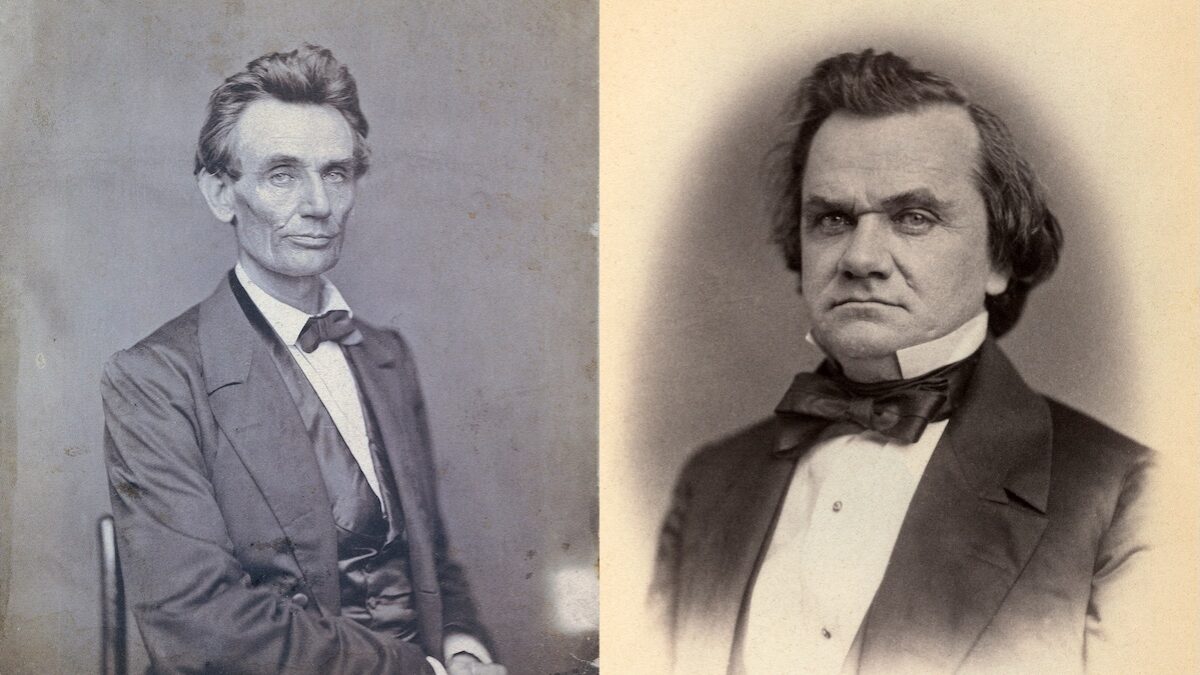
As it has been for decades now, abortion is at the center of the debate over the Supreme Court. With a solid majority of conservative justices in place, pro-lifers hope—and abortion rights advocates fear—the days in which Roe v. Wade is law of the land may be numbered.
Whether that is true or not, a decree from the court will not settle the issue any more than it did when Roe was written in 1973. Roe was wrong on the day it was written, but to settle the issue we must go beyond overturning it. The people must demand that the Constitution be amended to prevent rulings like Roe from happening again.
The authors of the Supreme Court’s disastrous ruling initially believed that taking the issue out of public debate and reshaping it as a constitutional right, via Roe v. Wade, would quiet the increasingly heated national argument. This has, quite obviously, not been the case. By shoehorning a right to abortion into the Constitution, the court only encouraged legal absolutists on both sides.
That should have been obvious to Justice Harry Blackmun and the six justices who joined his opinion. Rights are absolutes, with limits to them being rare exceptions. Inventing this new right only encouraged pro-abortion forces to press harder, just as defenders of actual rights do. Planned Parenthood v. Casey reshaped the administration of this right with one of the court’s inscrutable balancing tests, but left the main holding—the right to abortion—intact.
Precedent as a Double-Edged Sword
In judicial confirmation hearings, the principle of stare decisis takes center stage. This once was a bedrock principle in common law countries requiring that cases be decided in accordance with the decisions in earlier, similar cases. Now it is a tool that judges use more selectively, according to their own political wishes.
On the left, after the justices of the Warren Court ignored it for decades, stare decisis reemerged as a tool to preserve those progressive departures from precedent that had now become precedents themselves. Likewise, on the right, many who claim to honor precedent are willing to play the left’s game of looking the other way when the precedent is one they dislike.
Faced with a left-leaning Supreme Court that made itself into a super-legislature, advocates on the right have demanded the elevation of right-leaning judges who would vote their way instead. That is the normal reaction to the loss of a legislative chamber, but it should not be the reaction to a bad judicial result. When conservatives demand that the justices abandon stare decisis to overturn the holding in Roe, we are buying into the left’s philosophy. Instead of demanding that judges return to being judges, we agree that they should be politicians—as long as they are our kind of politicians.
This was not the way conservatives initially reacted to Roe. Three separate amendments were proposed in Congress in 1973 attempting to overturning Roe. More followed in 1975, 1979, 1981, and 1983; all were unsuccessful. Since then, legislative solutions have been proposed several times, including the Sanctity of Life Act in 1995.
While correcting an activist ruling is never as bad as creating one, it still brings us farther away from the way things are supposed to work. Pursuing both tracks—amendment and court ruling—directs us back toward the historical precedent.
The Means of Winning Matter
The legislative attempts did not succeed, but they followed the right principle. This is how bad court decisions are meant to be overturned, and why only the extreme consequences of Roe—millions of unborn babies being killed since 1973—justify abandoning stare decisis.
The broader principle remains: when the judiciary usurps the powers of Congress or the states, the answer is not to usurp it again in a different direction. The solution must be to restore the balance, to put the judiciary back in its proper place and take the power of legislation back for the state and federal legislatures.
We used to know that, and occasionally it still works this way. In 2007, in Ledbetter v. Goodyear Tire & Rubber Co., the Supreme Court made a ruling concerning the interpretation of a statute of limitations in the Civil Rights Act of 1964. Democrats took exception to this and, in 2009, amended the law to enact their version of what that provision should mean. The political branches overruled the judiciary, just as the Constitution meant them to do.
When the ruling is constitutional, rather than statutory, the bar is higher. Constitutions are not idly altered, and for good reason, but we have amended ours 27 times. Some of those amendments were in direct response to Supreme Court rulings. In 1895, the Court ruled in Pollock v. Farmers’ Loan & Trust Co. that Congress could not impose a direct income tax. It took 18 years, but Congress and the states amended the Constitution in 1913 to overturn that ruling. Whatever your opinion of the income tax, it is now, without a doubt, constitutional.
The New Dred Scott?
There are other examples. Many pro-lifers call Roe the Dred Scott of our age. It’s a fair comparison. But it should also call to mind how Dred Scott v. Sandford was overturned. Did President Lincoln appoint a bunch of new justices who then heard a challenge to it and ruled a different way? No: Congress passed the Fourteenth Amendment containing, among other things, an explicit rejection of the holding in Dred Scott. Eleven years after Justice Roger Taney’s deplorable ruling, Congress and the states reversed it.
There was also the intervening Civil War, a reaction far more extreme than abandoning stare decisis, but also one that was justified by the enormity of the acts Taney’s ruling had entrenched in law. As in Roe, the Supreme Court in Dred Scott took on a hot political issue and tried to solve it with a legal ruling. But Supreme Court rulings do not change anyone’s mind. Coming as they do without public debate and without popular support, they are seen only as impositions from nine judges who answer to no one.
A court ruling overturning Roe would be seen as similarly illegitimate from the side that opposes it. The ruling would be just, but it would only take us back to 1973. The court from that year imagined enough ambiguity in the Constitution to impose its ruling in Roe, and some future left-leaning Supreme Court could do so again. It would end nothing, and would only increase the monomania surrounding judicial appointments. Giving into the left’s demand that courts act as super-legislatures makes the courts the most important, most dangerous branch of government. It turns the constitutional structure on its head.
The final victory in overturning Roe will not come from a conservative version of Roe. A constitutional amendment, with the requisite nationwide discussion and debate, would have a better chance of restoring the constitutional order. Instead of using the courts to write one side’s view of things into the Constitution, an amendment restoring the federal balance would let the people decide things on their own, with more answers than the all-or-nothing structure of rights-based jurisprudence.
Consider an amendment like this one, which combines elements from those proposed in the 1970s and ‘80s: “A right to abortion is not secured by this Constitution. The power to regulate abortion is reserved to the states.”
The Constitution does not need to contain Justice Blackmun’s ivory-tower pronouncements on trimesters, nor Justice Anthony Kennedy’s florid prose on the mystery of life. Such calculations are the province of legislators, whose direct connection with the people make them better able to understand the popular will. An amendment like this one makes that possible.
It’s Only Been Getting Worse Since Roe v. Wade
The country remains divided on abortion. Restoring abortion policy to the states would mean New York’s barbaric law would govern there, allowing abortion on demand at any stage of pregnancy, while Alabama’s extremely restrictive statute would effectively ban the practice in that state. That is federalism; in an increasingly divided nation, it may be the only (and best) option we have left.
Pro-lifers may object to an amendment that would allow New York’s gruesome practices to remain, but that law is not too far from the current system. Plus, it would be the result anyway if Roe is overturned. On the other side of the ledger, returning the power to the states would decrease abortions in places where majorities of citizens do not want them and would lock in the results of overturning Roe. It’s a net gain for pro-life forces, and one that comes with democratic legitimacy.
Congress has shown no inclination to pass such an amendment, and certainly not by the supermajorities the Constitution requires. But the Constitution also allows another method: two-thirds of the states may call for a convention to propose amendments. This function has fallen into disuse, but it is designed to let the states reassert their power, even without the federal government’s permission. In Federalist 85, Alexander Hamilton said as much, writing that it would allow “state legislatures to erect barriers against the encroachments of the national authority.”
Whether Roe is overturned or not, the states must take back the authority originally reserved to them by amending the Constitution. People will debate the subject and elect representatives who will carry out their will. Besides removing the issue from the courts, it will force legislators to confront the more sanguineous laws like New York’s and allow them to consider whether some less extreme option might not better suit even the pro-abortion majorities of that state. The resulting discussions might even change some people’s minds—something a judicial decree never can do.









